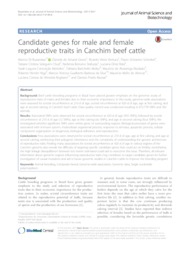 Busca de Publicações
Busca de Publicações
Candidate genes for male and female reproductive traits in Canchim beef cattle.
Author(s): BUZANSKAS, M. E.; GROSSI, D. do A.; VENTURA, R. V.; SCHENKEL, F. S.; CHUD, T. C. S.; STAFUZZA, N. B.; ROLA, L. D.; MEIRELLES, S. L. C.; MOKRY, F. B.; MUDADU, M. de A.; HIGA, R. H.; SILVA, M. V. G. B.; ALENCAR, M. M. de; REGITANO, L. C. de A.; MUNARI, D. P.
Summary: Background: Beef cattle breeding programs in Brazil have placed greater emphasis on the genomic study of reproductive traits of males and females due to their economic importance. In this study, genome-wide associations were assessed for scrotal circumference at 210 d of age, scrotal circumference at 420 d of age, age at first calving, and age at second calving, in Canchim beef cattle. Data quality control was conducted resulting in 672,778 SNPs and 392 animals. Results: Associated SNPs were observed for scrotal circumference at 420 d of age (435 SNPs), followed by scrotal circumference at 210 d of age (12 SNPs), age at first calving (six SNPs), and age at second calving (four SNPs). We investigated whether significant SNPs were within genic or surrounding regions. Biological processes of genes were associated with immune system, multicellular organismal process, response to stimulus, apoptotic process, cellular component organization or biogenesis, biological adhesion, and reproduction. Conclusions: Few associations were observed for scrotal circumference at 210 d of age, age at first calving, and age at second calving, reinforcing their polygenic inheritance and the complexity of understanding the genetic architecture of reproductive traits. Finding many associations for scrotal circumference at 420 d of age in various regions of the Canchim genome also reveals the difficulty of targeting specific candidate genes that could act on fertility; nonetheless, the high linkage disequilibrium between loci herein estimated could aid to overcome this issue. Therefore, all relevant information about genomic regions influencing reproductive traits may contribute to target candidate genes for further investigation of causal mutations and aid in future genomic studies in Canchim cattle to improve the breeding program.
Publication year: 2017
Types of publication: Journal article

